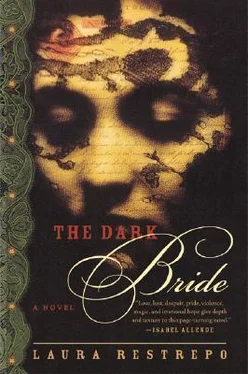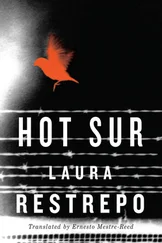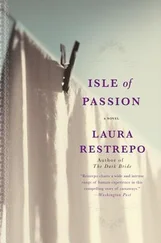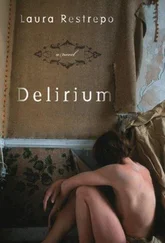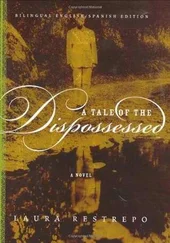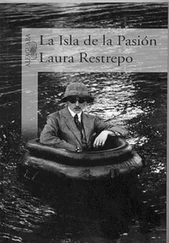Laura Restrepo
The Dark Bride
TO SANTIAGO,
FOR HIS HELP AND HIS LOVE.
I am as dark — but lovely,
O daughters of Jerusalem,
As the tents of Kedar,
as the curtains of Salma.
SONG OF SONGS
But who would know the way
to enter her heart?
SAINT-JOHN PERSE
Then slowly the night would open and the miracle unfold. Far off in the distance, against the immense, silky darkness, strings of colored lights would appear in La Catunga, the barrio of las mujeres, the women. Men, freshly bathed and splashed with cologne, would pile into trucks on payday and come down the mountain from the oil fields to the city of Tora, drawn like moths to a flame by those twinkling electric lights that held the greatest promise of earthly bliss.
“To see the lights of La Catunga from a distance? That was heaven, hermano, ” recalls Sacramento, who has suffered a great deal because of his memories. “For that, just for that, we would break our backs working in the cruel jungle, the four hundred workers of Campo 26. Thinking of that sweetness, we withstood the rigors of Tropical Oil.”
Day after day they waded through swamps and malarial dampness, until finally the moment arrived, at the far reaches of hope, when they would glimpse the lights of La Catunga, that barrio baptized by las mujeres in honor of Santa Catalina — la Santacata, the loving Catica, the compassionate Catunga — in accordance with their devotion to her, whether for her chastity, her martyrdom, her beauty, or her royal status as a princess.
“She had enormous castles and inheritances,” relates the elderly Todos los Santos of her princess and patron saint, “herds of elephants and three rooms overflowing with jewels that had been given to her by her father the king, who was proud to have a daughter more beautiful and pure than sunlight itself.”
On foot and hatless, almost reverently but snorting like calves and jingling the coins in their pockets — that is how on each payday the men entered those narrow, brightly lit streets they had dreamed of in their barracks, Mondays with hangovers, Tuesdays with the longing of orphans, Wednesdays with the fever of lonely males, and Thursdays with the ardor of the lovelorn.
“ Llegaron los peludoooos! Here come the shaggy men!” Sacramento says in falsetto to imitate a woman’s shout. “They called us the shaggy men because an oil worker was proud of arriving in La Catunga looking tough, tan, hairy and bearded. But clean and smelling fine, wearing leather boots and a white shirt, with a good gold watch, necklace, and ring to show off his salary. And always, as if it were a medal, his company ID visible on his lapel. The ID that identified you as an obrero petrolero, an oil worker. That, hermano, was our badge of honor.”
“ Llegaron los peludoooos! ” laughs Todos los Santos, showing the teeth she no longer has. “It’s true, that was the war cry. Tough and shaggy, that’s how we liked them, and when we saw them arriving we also shouted: Ya llegó el billete! Here comes the money!”
Back then Tora was distinguished in the great vastness of the outside world as the city of the three p’s: putas, plata, and petróleo, that is, whores, money, and oil. Petróleo, plata, and putas . Four p’s really, if we remember that it was a paradise in the middle of a land besieged by hunger. The lords and ladies of this empire? The petroleros and the prostitutas .
“We didn’t call them putas or rameras or other offensive names,” remembers Sacramento. “We just called them las mujeres, because for us there were no others. In the oil world, amor de café was the only recognized form of love.”
“Understand that Tora was founded by prostitutas according to our own law, way before the wives and fiancées arrived to impose their rights of exclusivity,” Todos los Santos tells me, regal and handsome despite her advanced age, as she finishes a glass of mistela with the manners of a countess and smokes a fat, odoriferous cigar of the traditional brand Cigalia, with gestures worthy of the equerry of that same countess.
“Have a little smoke, reina, ” she offers me, reaching out the hand holding the cigar a little toward where I am not sitting, and I realize that she can’t see very well.
“How could you think of that, doña, can’t you see I’m choking?” I say, and she laughs; she seems to think I’ve said something funny.
“The ones who hold back are the most vice-ridden.” She laughs and covers her mouth with her hand, like a little girl. “If you won’t smoke, then have a mistela . It’s refreshing and pleasant. Please don’t refuse me.”
In its early days word spread to the four winds that La Catunga was the optimal marketplace for love because of the abundance of money and availability of healthy males, so beauties all over the world packed their beads and baubles and came here to try their luck.
“Extraordinary beauties came here, improving upon what was already here,” says Todos los Santos dotingly, then coquettishly begging forgiveness for the lack of modesty. “There were some real ladies, all so very elegant and pious. The candleholders in the sanctuary of the Sagrado Corazón never had an empty slot. One didn’t go around brusquely or soil her mouth with foul words, or display poor manners as occurred later, two women fighting over a man and things of the sort. None of that. Vulgarity had no place among us.”
Since there were women from so many different places, tariffs were established based upon how exotic and distant a woman’s nationality was, or how sonorous her name and unusual her customs. Those who charged the most were the French: Yvonne, big and beautiful, the languid Claire, pale as the moon, and Mistinguett, who before coming to contend with the petroleros was a favorite of the painters in Montmartre.
“She always dreamed of returning to her country, that Mistinguett; she said that there she was paid just for allowing herself to be painted in the nude. There was also a painter who came here and used her as a model in a painting, but he was a modern painter, a lover of bright colors and foolish lines. She didn’t approve the portrait and scolded him: ‘That’s not me, it looks like a chicken. I should have charged you more for wasting my time. Where do you see feathers on me, fool? Go and paint chickens and see if they turn out like women.’ She said all that and then to add insult to injury she told him that he painted unholy messes and had reawakened her anxiousness to leave the country, because in France painters truly knew their trade.”
In the strict classification by nation, after the French came the Italians, ill-tempered but professional in their work, and as the scale descended came the girls from surrounding countries such as Brazil, Venezuela, or Peru, then came the colombianas from the various regions in general, and on the bottom rung the native Pipatón Indians, who were at a disadvantage because of racial prejudices and because they were the most abundant.
Men of varying talent and diverse plumage made the trip to this utopian place to taste a mouthful of olive flesh, or blond, or mulata —of every kind and in willing abundance, without reproach or commitment, in a harmonious blend of guaracha, tango, and milonga music. There’s nothing like the vice of sweet love to kill longings and loneliness with tender kisses at the edge of a river, between sips of champagne or rum, with words whispered in one’s ears perhaps in Italian, or maybe Portuguese, nearly always in baby talk.
Читать дальше
